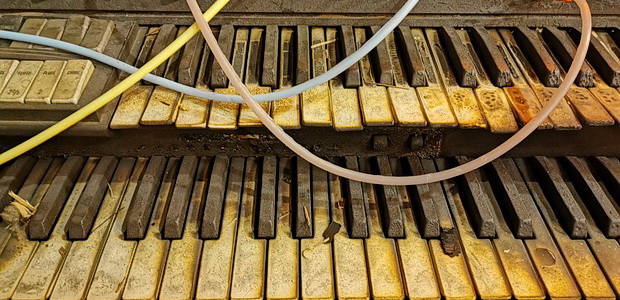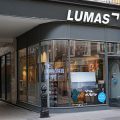
Bewildering, beautiful, absurd and entertaining, the Colony Sound installation at the Marlborough Gallery in London is an absolute delight.
A multi-floor immersive installation by Jonah Freeman and Justin Lowe, Colony Sound draws visitors through eleven rooms that assault the senses, with corridors leading to a dystopian mobile phone shop, a burnt out recording studio, a shopping arcade and other strange destinations.
A look inside the bunk beds.
Cafe.
Cacti and crystals in a medical room.
A copper room used to shield from electromagnetic waves.
The half incinerated recording studio.
A wax microphone hands from the ceiling.
Up to the top floor.
A hole ripped in the wall takes you into another room.
A black foam photocopier.
The entrance hosts a shop displaying curious technology.
Here’s a video taken on the top floor of the installation:
Here’s how the gallery describes the work.
I’m not sure I entirely understand what they’re on about – but who cares? – the installation is great fun!
COLONY SOUND represents the latest chapter in the artists’ San San Universe. This episode is focused on a set of relationships surrounding the evolution of an obscure 20th century communication system known colloquially as The Smile. The previous chapter, A Cell in The Smile, which is buried in an underground bunker somewhere in Ohio, begins the story in the technoscape of cold war California.
This is the era when paranoid scientific achievements ushered in several new stages of unreality. Aerospace, microchips and the entertainment industry all flourished in the heady days of post-war West Coast. COLONY SOUND picks up as the hybrid fruits of neo-biological technology are appropriated by emergent sub-cultures in an attempt to remake society.
In this exhibition, Jonah Freeman & Justin Lowe riff on the historical narratives surrounding The Smile to create a sprawling architectural intervention that oscillates between the habitats of the counterculture and the sites of technological invention.
A series of eleven rooms that range from a telecommunications retail outlet, a half- incinerated recording studio, a copper room used to shield from electromagnetic waves, a shopping-arcade- turned-youth-habitat and a drop out lounge constructed of homemade ceramics. Within these environments are multiple series of art objects that reposition the matter of The Smile and its cultural byproducts in purely physical and spatial terms. The objects and environments drain the illusory and confront the visitor with the material edge of media technology.
Psychic Driving was originally a clinical term for a psychiatric technique that used looped audio messages as a method to reprogram a subject’s identity. Depatterning, as they called it, was for a short moment the ideal weapon in the war of the mind. The Smile was developed by Claude Shannon and Adita Smiley as the first biological network to be used for mass transmission of Psychic Driving. In their bunker laboratory they managed to synthesize a terrestrial and aquatic vegetative network that could transmit a full spectrum of electromagnetic waves.
The organic substrate of The Smile made the electromagnetic signals impossible to hack and infinitely more stable than traditional electronic methods. This was the first biological telecommunication system. Shannon and Smiley called the technology Mycotecture and stated that “The Smile will connect the central nervous system of all humans into a global communication network where the separations between biology, technology and the landscape will be imperceptible.”
Their vision was never achieved. Psychic Driving was deemed unreliable and The Smile was abandoned and would remain dormant for decades before it was resurrected in a beachside slum.
COLONY SOUND first emerged as a youth gang in the Nippono-Caribbean immigrant communities of the San San. They repurposed The Smile as a method of transmission for the sonic-fictions that undergirded the diasporic population.
Unearthed in the very bunker where it was first conceived, the founding members of COLONY SOUND, Farmer Kintaro and R.F. Saxon, discovered The Smile’s ability to transmit inaudible and unknown sound vibrations with pristine fidelity. This allowed them to lay the pipes for a pirate media state. Before long global subcultures would pervert and remix the paranoia-inspired achievements of The Smile into new forms of youth rebellion; music, individuality and alternative lifestyles.
As these subcultures seeped into the mainstream The Smile becomes the vehicle for the 21st century marketing of total leisure environments and affirmation capitalism. The original COLONY SOUND and the abandoned shopping malls were dissolved into a new real estate development called The Glass Field. In this new urban ecology, The Smile becomes the telecommunication network for a deranged wellness program. Human potential manifested in the architecture of leisure.
The Glass Field is the city as a sprawling resort. A sequence of brutalist pleasurescapes designed for total withdrawal. Each interior space of The Glass Field functions like an island seemingly separate and self-contained. These islands are then connected through The Smile which brings a seamless exchange of fantasies. The passage from one island to the next plays out like a stream of consciousness montage. Spatio- temporal logic is subverted by cascades of nonsensical connections.
This visitor book comment summed up the experience perfectly.
More information
Marlborough Gallery
6 Albemarle Street
London W1S 4BY
+ 44 (0) 20 7629 5161
Exhibition runs until 19th Oct 2019
Gallery Hours
Monday through Friday: 10am — 5:30pm
Saturday: 10am — 4pm
Admission free


